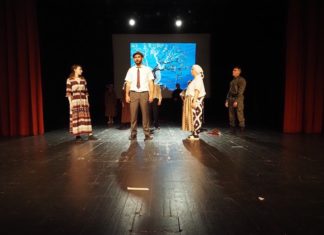We have already written about the graffiti that celebrate violence and hatred on Phralipen. There are still many of those in Zagreb, and for decades the city authorities approached them only as acts of vandalism, as was pointed out in reports on the occurrence and measures to prevent graffiti. The difference between the content of the messages written and drawn on the walls and streets was not, and is still mostly not, made. Everything is crammed together under the definition of “destruction of property” and “defamation of the city”, which is a narrow and flawed understanding of hate speech and street art, respectively.
Street art as a way of resistance
A lot of attention, especially in the minority media, is correctly devoted to hate graffiti, especially to the need to adequately contextualize their appearance. However, with this text, we would like to divert the attention towards graffiti and murals, which are an expression of (self)organization for a positive change.
Street art has its roots in rebellion and resistance. Often, it was the only tool of the urban poor, the disenfranchised, and the marginalized. Walls, asphalt, train carriages, and street poles, were appropriated as a spot for expression by those who mostly did not have their place in society, and the privileges or possibilities that came with it. The motivation and creative imperative behind it were dissatisfaction, poverty, and urban decay. The streets became a space for articulating problems but were also used as a surface for imagination – through stirring graffiti and murals, which were used to draw the way out from the rut of despair.
As such, street art is probably the most progressive artistic expression, in terms of the broadness of its expression, freedom of participation, the enormity of the “canvas” and those who create it, but also those who observe it and continuously engage with it. Any surface can be a canvas. Education is not a factor that determines the possibility of participation in the creation of an artwork, as well as engagement with it. The street as a medium has brought artistic, but also activist, and political expression closer to generations of people who are not welcomed in places normally intended for articulating these purposes – galleries, colleges, libraries, etc.
A lot has changed in the context of street art in recent decades – it is less and less created without legal permission (which weakens the power of criticism and reduces its rebellious potential). There is a noticeable shift from graffiti to murals (muralists are more often paid for their work, which is good, but this encourages and highlights only the more narrow category of street art and expression). The use of street art for commercial-tourist purposes is incresingly more common, as well as for “beautifying” neighborhoods through gentrification interventions (as opposed to the earlier activist core of this art movement). Despite these issues, the potential for creation in the streets always exists, and it is important to point out the need to use and appropriate the public space, to inscribe one’s existence in it.
Collectives for change
Instead of focusing on individual artists (like Banksy), we will mention several collectives that are stimulating examples of (self)organization, stressing the activistic component of their work.
WOM Collective is a London-based collective of female artists and activists, who have been creating, for years, a space for female artists to exhibit and sell their street artwork. But they also act as activists – by organizing workshops in various neighborhoods, involving the local community in painting city walls, connecting with other collectives, participating in street exhibitions, concerts, film screenings, etc. They are especially dedicated to feminist work, writing and painting feminist graffiti and murals in London, but also abroad (this year, on March 8th, they organized the Mural Trail, feminist gatherings around London).
The Few and Far Women collective has been active in the USA since 2011, and in its ten years of existence, it has managed to connect activists from Miami to Hawaii and Costa Rica. They jointly created, for example, murals dedicated to the Black Lives Matter movement in Sacramento. In addition to large public murals, Few and Far organizes and participates in numerous skateboarding events across America and beyond, advocating the empowerment of women and their bolder appearance in public space, in a subculture that is still dominated by men. The collective has members from Los Angeles, San Francisco, Oakland, Sacramento, New York, Miami, Seattle, New Jersey, Great Britain, Ecuador, Venezuela, Mexico, Kathmandu, and Australia. Their street, it seems, has no end. We would love to see at least one of their murals in ours.












